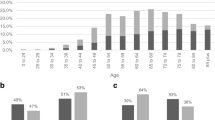Abstract
BACKGROUND
Data on gender- and age-specific predisposition to colorectal tumors and colorectal tumor location and stage among the urban minority population in Northeastern United States is limited.
OBJECTIVE
To study the age and gender distribution of colorectal tumor type, location, and stage of colorectal tumors among urban minorities.
DESIGN
Retrospective analysis of a database of 4,043 consecutive colonoscopies performed over a 2-year period.
PARTICIPANTS/MEASUREMENTS
Of study participants, 99% were Hispanic or African American and two-thirds were women. Age, gender, colonoscopy findings, and biopsy results were analyzed in all study subjects. Outcome measures are expressed as odds ratios (OR) with 95% confidence intervals (CI).
RESULTS
Colonoscopies, 2,394 (63.4%), were performed for cancer screening. Women had higher visit volume adjusted odds to undergo colonoscopy (OR 1.35; CI 1.26–1.44, P < .001). Individuals, 960 (23.7%), had adenomas, and 82 (2.0%) had colorectal cancer. Although cancers were outnumbered by adenomas in the colon proximal to splenic flexure (OR 0.48; CI 0.29–0.80 P = .002), 51% of all abnormalities and 35.4% of cancers were found in this region. Of cancers, 75% belonged to AJCC stage 0 to 2. Men had higher odds for both adenomas and cancers (OR 2.38, CI 2.0–2.82, P < .001). More polyps occurred at a younger age. Of the cancers, 38% were noted among the 50- to 59-year-old subjects. However, the odds of colorectal cancers were higher at age greater than 70 years (OR 1.91; CI 1.09–3.27, P < .05), specifically among men (OR 2.27, 95% CI 1.07–4.65, P < .05).
CONCLUSION
Our study of colonoscopies demonstrates lower odds of colonoscopy after adjusting for visit volume and greater predilection for colorectal cancer among urban minority men. Although older individuals were more likely to have colorectal cancer, a high percentage of colorectal tumors were noted at a younger age. These findings emphasize the vital need for preventive health education and improving early access to colorectal screening among urban minority men. A large proportion of colorectal tumors were found proximal to splenic flexure, which supports colonoscopy as the preferred method for colorectal cancer screening in the urban minority population in New York City.
Similar content being viewed by others
References
American Cancer Society. Cancer facts and figures, 2005. Atlanta (GA): American Cancer Society; 2005.
Ries LAG, Eisner MP, Kosary CL, et al. SEER Cancer Statistics Review, 1973–1999. Bethesda, MD: National Cancer Institute; 2002.
Surveillance, Epidemiology, and End Results (SEER) Program (http://www.seer.cancer.gov) SEER*Stat Database: Mortality-All COD, Public-Use With State, Total U.S. for Expanded Races/Hispanics (1990–2002), National Cancer Institute, DCCPS, Surveillance Research Program, Cancer Statistics Branch, released April 2005. Underlying mortality data provided by NCHS (http://www.cdc.gov/nchs).
Thorpe L. Colon Cancer Surveillance & Evaluation. http://www.nyc.gov/html/doh/downloads/ppt/cancer/cancercolon-thorpe.ppt.
O’Brien K, Cokkindies V, Jemal A, Cardinez CJ, Murray T, Samuels A, et al. Cancer statistics for Hispanics, 2003. CA Cancer J Clin. 2003;53:208–226.
Thorpe LE, Mostashari F, Feldman G, et al. Cancer screening in New York City: we can do much better. NYC Vital Signs. 2003;2(2):1–4.
Strul H, et al. The prevalence rate and anatomic location of colorectal adenoma and cancer detected by colonoscopy in average-risk individuals aged 40–80 years. Am J Gastroenterol. 2006;101(2):255–262.
Thorpe LE, Mostashari F, Hajat A, et al. Colon cancer screening practices in New York City, 2003: results of a large random-digit dialed telephone survey,” ANCER; Published Online: July 25, 2005 (doi: http://10.1002/cncr.21274); Print Issue Date: September 1, 2005.
Nash D, Azeez S, Vlahov D, Schori M. Evaluation of an intervention to increase screening colonoscopy in an urban public hospital setting. J Urban Health. 2006;83(20):231–243.
Colon and rectum. In: American Joint Committee on Cancer: AJCC Cancer Staging Manual. 6th ed. New York, NY: Springer, 2002, pp 113–124.
Demographic Characteristics—Bronx Community District 1990 and 2000 Census. http://www.nyc.gov/html/dcp/pdf/census/demo_cd_bx.pdf.
Subramanian S, Amonkar MM, Hunt TL. Use of colonoscopy for colorectal cancer screening: evidence from the 2000 National Health Interview Survey. Cancer Epidemiol Biomarkers Prev. 2005;14:409–416.
Morgan C, Park E, Cortes DE. Beliefs, knowledge, and behavior about cancer among urban Hispanic women. J Natl Cancer Inst Monogr. 1995;(18):57–63.
Lieberman DA, Holub J, Eisen G, Kraemer D, Morris CD. Utilization of colonoscopy in the United States: results from a national consortium. Gastrointest Endosc. 2005;62(6):875–883.
Intercultural cancer council caucus. From awareness to action. Eliminating the unequal burden of cancer. March 2004 report. http://icc-caucus.org/ICC-CaucusActionPlan.pdf.
Lieberman DA, Weiss DG, Bond JH, Ahnen DJ, Garewal H, Chejfec G. Use of colonoscopy to screen asymptomatic adults for colorectal cancer. Veterans Affairs Cooperative Study Group 380. N Engl J Med. 2000;343(3):162–168.
Nicholson FB, Korman MG, Stern AI, Hansky J. Distribution of colorectal adenomas: implications for bowel cancer screening. MJA. 2000;172:428–430.
SEER cancer statistics review 1975–2001 NCI. http://seer.cancer.gov/csr/1975_2001/results_merged/topic_race_ethnicity.pdf.
Acknowledgements
No additional individuals participated in the manuscript preparation other than the authors listed in the title section. Financial support for patient navigation was provided by the City of New York Trust Fund.
Conflict of Interests
None disclosed.
Author information
Authors and Affiliations
Corresponding author
Rights and permissions
About this article
Cite this article
Kanna, B., Schori, M., Azeez, S. et al. Colorectal Tumors Within an Urban Minority Population in New York City. J GEN INTERN MED 22, 835–840 (2007). https://doi.org/10.1007/s11606-007-0156-x
Received:
Revised:
Accepted:
Published:
Issue Date:
DOI: https://doi.org/10.1007/s11606-007-0156-x




